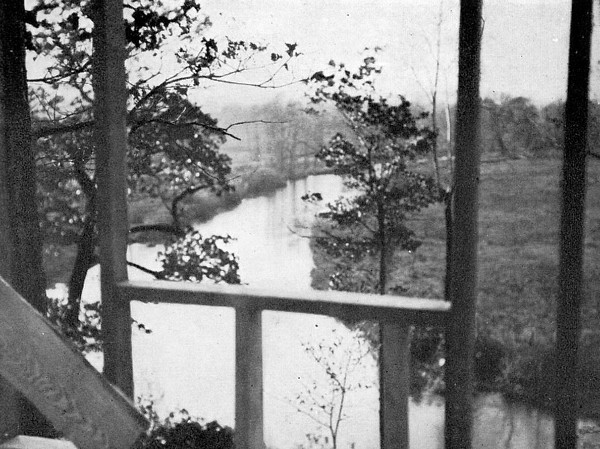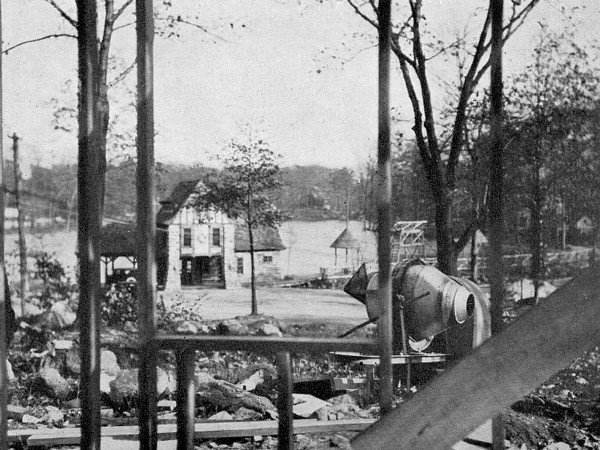| Web
and Book
design,
Copyright, Kellscraft Studio 1999-2012
(Return
to Web
Text-ures)
|
 (HOME)
|
| CHAPTER
I
HOW IT ALL STARTED ANYONE can build a house. All you need is a plan, a few bids and the price — and there you are. But that wasn't the kind of a house we wanted. We hoped to build a home that we should like better every year we lived in it — something that we could point to with pride instead of viewing with alarm. We hoped to accomplish that "white house with green blinds" effect that you see so often in your fancy and so seldom by the roadside. It was risky to attempt a type of house that none of our local carpenters or masons was familiar with. The houses we had in mind became obsolete a hundred years before present-day operators were born. It was also risky for a layman to attempt to design such a house without benefit of clergy or architects. It is mighty easy to fall for trick stuff when you design your own house no matter what type it may be. Some of the favorite tricks of amateur house planners are unexpected steps up or down, that make a caller lucky to escape with a barked shin instead of a broken neck. Then there are those narrow, curving cellar stairs, which — because they lack sufficient headroom — make you lift your voice to high heaven every time the floor beam above cracks you in the skull. There are doors that swing the wrong way, electric light switches that make you paw over a half acre of wall to find, rooms so poorly lighted that they resemble an Egyptian tomb.
Planning to avoid
these
things is usually the job of an architect. But I had already planned
and built nineteen houses. So I decided that the twentieth house,
like a Mormon wedding, wasn't exactly an amateur performance. But
whether one plans his own house or not, anyone can decide upon the
type of house he wants. An architect doesn't need to settle this for
you any more than a waiter needs to tell you what to eat. The fact is
that millions of people are dissatisfied with homes that someone else
has planned. Are you satisfied with yours? This is only a rhetorical
question. The answer is "no."
 Looking out of the Rear Windows toward Rockaway River.  Looking out of the Front Windows toward Lake Arrowhead.
As far as I know, man is the only two-legged animal except a cuckoo bird who is content to live in a house that someone else plans and builds for him. The cuckoo bird, it seems, goes a little farther than we do. He (or I guess it must be she) comes around when the builder of the nest is away and lays her eggs. She is apparently as well satisfied with this arrangement as people who live on delicatessen store food, or subscribe to a book club instead of selecting their own reading matter. To me, there is something almost pitiful in the lot of a bird who can't say, "John and I planned this beautiful nest. It was always a hobby with us. We thought out every last detail. John should really have been an architect, anyway. . . ." You can finish this line of conversation for yourself. You have heard it often enough. We didn't want to be cuckoo birds. We wanted to build our own nest. True, we wanted modern conveniences but we hoped to have them in a restful, soul-satisfying setting. The fireless cooker mustn't crowd out the family hearthstone. Planning this house was not a lone effort by any means. My wife and I discussed every essential detail many times. These discussions did not always encourage the dove of peace to perch on the lintel either. Sometimes our talks resembled an extra session of Congress met to consider farm relief. But in the end we mapped out our course and stuck to it. The editorial ''we" shouldn't be limited to kings, Lindbergh and modest authors. It should always include house planners. Any house starts with the site. In selecting that, you write your own ticket. Whether you secure a fifty-foot lot in a new development, or an acre or two in the suburbs with a brook perhaps, some big trees and a kind-faced cow in the pasture, is up to you. With any site, however, it is well to consider some things that may not be apparent at first. Will you have a wet cellar because the ground is low? Is there a soap factory or a tenement district nearby? Will drilling freight engines or honking automobile horns make night hideous? Is your next-door neighbor a piccolo player? It is a mighty good plan to visit any homesite you plan to buy without the real estate agent. Spend a little time on the property. Perhaps you will be able to find out whether your little Elmer is going to like that freckle-faced Jones boy across the street, or whether the Jones boy isn't apt to give little Elmer a sock in the jaw in a day or two. Neighbors can make or break a home more than anything I know of. We once rented a summer cottage on the Shore. All the cottages on our street had names, ''Dew Drop Inn," ''Camp Rest-a-While," and "Solid Kumfort," were some, but the worst was yet to come. Every house on the street had cats — dozens of them all told. One old couple near us had a cat that was eighteen years old. And I had two wire-haired fox terrier dogs. Big dogs bark at cats, but terriers are a killer breed. When they see a cat, they see red (and so do I, for that matter). In three days my doggies had searched out and chased every available cat in the neighborhood including the old grandma tabby, eighteen years old. True, I did not want my dogs to do this, but our family had something better to do than to act as nursemaid for a village of cats. One of the reasons why I gave up my suburban house and moved to the seashore was to give the dogs more freedom. It was certainly one hectic summer. When I came home, a tired business man after a hard day in Boston, usually there were cats treed on every available telegraph pole. Ladies in aprons with dishes of milk were wasting a tremendous lot of energy calling, ''kitty, kitty" in a vain effort to get them down. One evening when taking a stroll, my dogs spied a cat and dashed in hot pursuit right through a neighbor's porch. It happened that he and some friends were playing pinochle. The dogs upset the pinochle table and frightened an old aunt so thoroughly that I am sure she will never be the same again. Of course, my dogs were in the wrong, but I was obliged to defend them just as they would defend me, even with their little lives. But the feud was on in full force. All I got from my neighbors for the balance of the summer were black looks. And to add fuel to the fire, my playful cousin, who had been visiting us, wrote me a letter addressed to "Tom Cat Alley." The postmistress told my neighbors of it. The result was a friendship between my neighbors and me as warm as that between Senator Heflin and the Knights of Columbus. When you move to a new neighborhood how about train service? Do they plow the road you plan to live on in winter to get rid of snow, or will it sometimes be impassable? Are you going to be on the end of a gas main so inadequate that you can't get enough gas to boil an egg, when the rest of the street cooks Sunday dinner? Is your street paved, or will it be a sea of red mud in the spring? Are there restrictions on adjacent property, or will you wake up some morning to see a tenement house or a public garage started next door? When you buy land, let the doctrine of caveat emptor be your motto. It is simply the way Roman realtors used to say, "Never give a sucker an even break." |